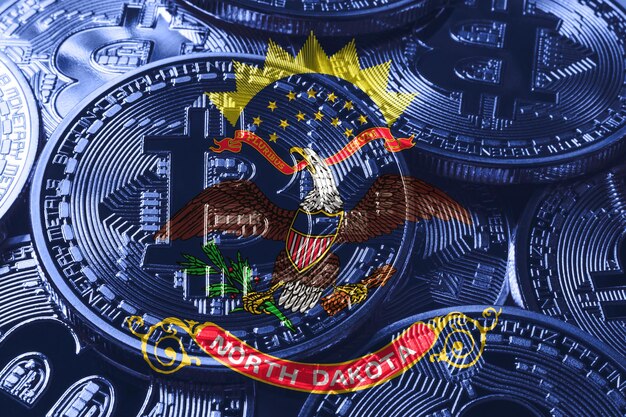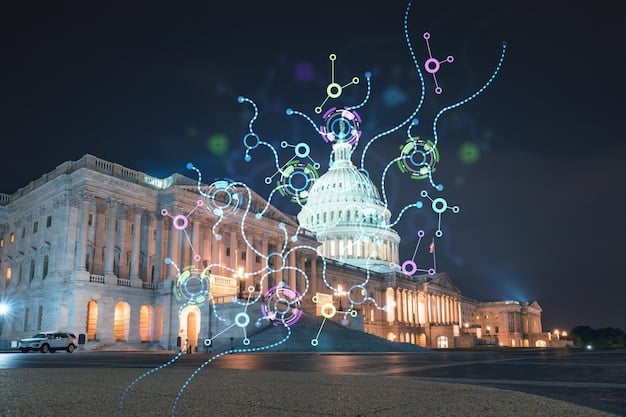Stablecoin Regulation: Impact of New US Laws on Altcoins

Stablecoin regulation in the US is evolving, with potential new laws impacting the altcoin market by influencing investor behavior, market stability, and the overall regulatory landscape for cryptocurrencies.
The cryptocurrency market is bracing for potential shifts as stablecoin regulation gains momentum in the US. New laws could significantly impact the altcoin market, affecting everything from investor confidence to market dynamics. What does this mean for the future of digital assets?
Stablecoin Regulation: An Overview
Stablecoins have emerged as vital components of the cryptocurrency ecosystem, providing stability amidst the volatility often associated with digital assets. Understanding the basics of stablecoins and their role is crucial before diving into how regulations might affect them.
What Are Stablecoins?
Stablecoins are cryptocurrencies designed to maintain a stable value, typically pegged to a fiat currency like the US dollar. This peg aims to provide a safe haven for traders and investors, reducing the risk of price fluctuations.
The Role of Stablecoins in Crypto
Stablecoins facilitate trading, lending, and borrowing in the DeFi space. They serve as a bridge between traditional finance and the crypto world, making it easier for institutional investors and everyday users to participate in the digital economy.

Regulations are being proposed due to concerns about financial stability, consumer protection, and illicit activities. These concerns are influencing the push for clearer rules and oversight.
- Financial Stability: Regulators aim to prevent stablecoins from destabilizing traditional financial systems.
- Consumer Protection: Ensuring that stablecoin holders are protected from potential losses or fraud.
- Illicit Activities: Addressing concerns about money laundering and other illegal uses of stablecoins.
Stablecoins have become a critical trading tool, and regulations are an urgent concern for the entire crypto industry.
Current US Regulatory Landscape for Stablecoins
The US regulatory landscape for stablecoins is fragmented, with various agencies and legislative bodies working to establish comprehensive rules. Understanding the current state of regulatory efforts is essential for anticipating future changes.
Existing Laws and Guidelines
Currently, no specific federal laws govern stablecoins. Instead, existing regulations related to money transmission, securities, and banking are being applied, creating a patchwork approach.
Key Regulatory Bodies Involved
Several US agencies are involved in overseeing stablecoins, including the Securities and Exchange Commission (SEC), the Commodity Futures Trading Commission (CFTC), and the Treasury Department.
- SEC: Focuses on whether stablecoins qualify as securities and require registration.
- CFTC: Examines whether stablecoins fall under its jurisdiction as commodities.
- Treasury Department: Addresses broader financial stability and money laundering concerns.
Different frameworks can create uncertainty and compliance challenges for stablecoin issuers and users.
Proposed Legislation on Stablecoins in the US
Several pieces of legislation are being proposed to address the regulatory gaps surrounding stablecoins. These proposals aim to provide a clear framework for stablecoin issuance and operation, with potential implications for the broader crypto market.
Key Provisions of Proposed Bills
Proposed bills often include provisions related to licensing requirements, reserve management, and redemption policies for stablecoin issuers. This can include requiring stablecoins to be backed by reserves in cash or highly liquid assets. It can also require regular audits.
Potential Timeline for Implementation
The timeline for implementing stablecoin legislation is uncertain, as bills must pass through Congress and gain presidential approval. However, there is growing bipartisan support for stablecoin regulation, which could expedite the process.

The specifics can vary depending on the final version of the legislation, which could cause significant shifts in the crypto regulatory landscape.
Proposed legislation to regulate stablecoins has the potential to affect the rest of the crypto industry.
Impact on Altcoins: Direct and Indirect Effects
New stablecoin regulations could have both direct and indirect effects on the altcoin market. Understanding these potential impacts is crucial for investors and projects operating in the crypto space.
Direct Effects on Altcoin Trading
If regulations increase the cost or complexity of using stablecoins, it could reduce liquidity in the altcoin market. Traders might find it more difficult or expensive to convert fiat currency or stablecoins into altcoins.
Indirect Effects on Investor Sentiment
Regulatory clarity regarding stablecoins could boost investor confidence in the broader crypto market, leading to increased investment in altcoins. Conversely, strict regulations could dampen enthusiasm.
This could include more institutional investors to enter the crypto space. The ripple effects of stablecoin regulation will be felt in various corners of the industry.
- Market Volatility: Regulatory changes could trigger short-term volatility in altcoin prices.
- Innovation: Stricter rules for stablecoins could stifle innovation in the DeFi sector.
- Adoption: Clear regulations could encourage wider adoption of cryptocurrencies among mainstream users.
The specifics can depend on the nature of the regulatory changes and how the market interprets them.
How Altcoin Projects Can Adapt to New Regulations
Altcoin projects need to be proactive in adapting to the evolving regulatory landscape. By taking steps to ensure compliance and mitigate risks, projects can position themselves for long-term success.
Ensuring Compliance with Regulations
Altcoin projects should closely monitor regulatory developments and seek legal advice to ensure they comply with any new requirements related to stablecoins or other aspects of their operations. This includes implementing robust KYC/AML procedures.
Diversifying Stablecoin Usage
Projects should consider diversifying the stablecoins they use for trading, lending, and other activities. Relying on a single stablecoin could expose them to risks if that stablecoin faces regulatory challenges.
Ensuring long-term success in the crypto market requires a focus on compliance and risk mitigation.
Consider diversifying and adapting and focus on innovation that supports a more compliance-focused ecosystem.
The Future of Stablecoins and Altcoins in the US
The future of stablecoins and altcoins in the US depends on how regulators balance the need for oversight with the desire to foster innovation. The path forward will likely involve ongoing dialogue between regulators, industry participants, and policymakers.
Potential Scenarios for the Market
One scenario is that clear and well-defined regulations could lead to greater stability and mainstream adoption of stablecoins and altcoins. However, overly restrictive regulations could stifle innovation and drive activity offshore.
Importance of Innovation and Compliance
Striking a balance between innovation and compliance will be crucial for ensuring the long-term success of the crypto market in the US. Regulations should be flexible enough to accommodate new technologies and business models, while also protecting consumers and the financial system.
The evolution of the regulatory landscape for stablecoins and its impact on altcoins will require cooperation and proactive adaptation.
| Key Point | Brief Description |
|---|---|
| 💡 Stablecoin Basics | Stablecoins maintain a stable value, often pegged to fiat currencies. |
| ⚖️ US Regulation | Regulatory bodies include SEC, CFTC, and Treasury, focusing on different aspects. |
| 📉 Altcoin Impact | Regulation affects trading liquidity and investor sentiment towards altcoins. |
| 🛡️ Adaptation | Altcoin projects should ensure compliance and diversify stablecoin usage.. |
FAQ
▼
Stablecoins are cryptocurrencies designed to maintain a stable value, crucial for trading and providing a bridge between traditional finance and the crypto market. They reduce volatility and facilitate transactions.
▼
Regulation can affect liquidity, making it more costly to trade altcoins. Increased complexity might deter some investors, reducing the availability of funds injected into altcoin markets.
▼
Key bodies include the SEC, CFTC, and Treasury Department. Each focuses on different aspects such as securities compliance, commodities oversight, and broader financial stability.
▼
Altcoin projects should ensure compliance with new rules, diversify their stablecoin usage, and seek legal advice to navigate the evolving regulatory landscape. Focus on transparency to maintain consumer protection.
▼
The timeline is uncertain as new legislation must pass through Congress and be approved by the President. However, bipartisan support could expedite the process, making it crucial to continue monitoring updates.
Conclusion
The evolving regulatory landscape for stablecoin regulation in the US presents both challenges and opportunities for the altcoin market. Proactive adaptation, vigilance, and a commitment to compliance will be key for altcoin projects navigating this changing environment, and staying well-informed remains the best course of action for everyone involved.





